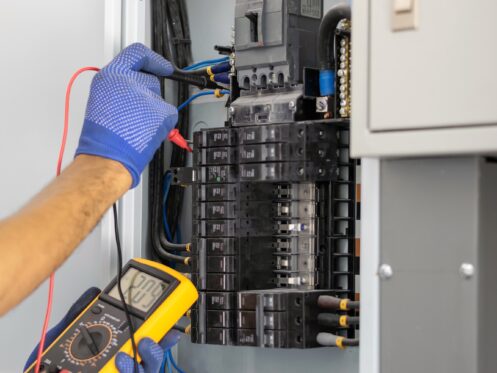When you’re looking to buy or sell a home, one thing you don’t want to forget about is an electrical inspection. This inspection plays a pivotal role in ensuring a smooth sales process. Below, our electrical services team will discuss what electrical inspections entail and why you should be getting one regardless of whether you’re the buyer or the seller of a home.
What Are Electrical Inspections?
An electrical inspection occurs when a licensed electrician comes out to your home and does a thorough evaluation of the entire electrical system in the residence. An electrician will be looking for proper installation techniques, code compliance, and optimal system safety. They’ll ensure that your electrical system can handle typical electrical demands.
During an electrical inspection, every component of your system will be examined and tested. This includes your wiring, electrical service panel, light switches, outlets, grounding system, lighting fixtures, and even your appliance connections. An electrician will be on the lookout for any code violations, fire hazards, insufficient service capabilities, and even age-related deterioration.
Considerations for Buyers
Electrical inspections are an absolute must for any home buyer to ensure that they’re making a wise financial investment. An inspection will detect faulty wiring, outdated electrical panels, exposed wiring, improper grounding, or other safety issues. By uncovering these issues before you purchase a home, you can better negotiate with the seller on the purchase price to cover the cost of repairing these hidden problems.
Getting an electrical inspection is necessary to ensure that the home’s electrical system is up to current local code enforcement. This isn’t only important for being compliant as a homeowner but is typically necessary to obtain financing from a mortgage lender. When you order an electrical inspection, talk to your electrician about what your plans are for the home, like adding an EV charging station or additional appliances. When we conduct an inspection, we can check the existing electrical system to see if it can accommodate your desires or if it will need upgrading.
There’s no doubt that electrical inspections are a great way for prospective home buyers to better understand the property that they’re considering purchasing. You can verify its safety and protect yourself from hidden wiring troubles, like aluminum wiring or knob and tube wiring that requires a full replacement. An inspection can go a long way in providing you with peace of mind about purchasing your new home.
Considerations for Sellers
While electrical inspections are a necessity for home buyers, they’re also a great investment for home sellers. Being able to present proof of a passing electrical inspection will help reassure potential home buyers that your home is safe and may speed up the sales process. Homebuyers are willing to pay more for homes that receive routine upkeep than those that don’t.
If your electrical inspection does show problems with your home’s electrical system, you can address them before selling your home. This will help avoid any last-minute problems that the buyer may experience when getting their own electrical inspection. This will also allow you to avoid any major expenses for repairs after you’re under contract.
One thing to keep in mind is you must disclose any problems with your electrical system as an ethical seller. If you know that you have pre-existing problems, you’ll need to tell the buyer which can affect their purchasing decision.
By getting an inspection and repairing any problems, you can have the peace of mind that you are giving the buyer accurate information about the state of your home’s electrical system. Furthermore, you can streamline the process when it comes to mortgage lenders and insurance companies wanting proof of an updated electrical system.
Common Electrical Inspection Findings
Most home buyers will routinely get an electrical inspection on any home that is over 30 years old. If you’re looking to purchase a newer home, you may consider skipping an electrical inspection, thinking that everything’s up to code. Keep in mind that even newer homes can have incorrect electrical work due to DIY renovations or additions that didn’t have proper permitting.
This is why it’s so important to always invest in an electrical inspection regardless of the age of the home that you’re thinking about purchasing. There are many different problems that may be discovered because of an electrical inspection. We’ll discuss some of the most common issues below so you can be better informed on the topic.
Old Wiring
If the home you’re thinking about purchasing is over 40 years old, it may have outdated electrical wiring. Some of the most common types of outdated wiring include cloth-insulated, knob and tube, and aluminum wiring. If a home has outdated wiring, it will need full rewiring to bring it up to modern-day code standards.
This is a big cost for a homeowner and is invasive when it comes to removing sections of your floors and walls to access the old wiring. As a home buyer, it’s important to wrap this cost into the concessions or opt for lowering your bid price based on an estimate for rewiring the entire home.
Outdated Electrical Panels
Homes built before the 1980s typically had only 60 amps to 100 amps of power going to them. Modern-day homes get anywhere between 200 amps and 250 amps because we have so many more electronics and appliances than we did just a few decades ago. If the home you’re thinking about purchasing doesn’t have a 200-amp electrical panel, it’s necessary to upgrade. This could require adding new wiring to the home as well, depending on the state of the existing wiring.
Missing GFCI Protection
Modern-day electrical codes require ground fault circuit interrupters, or GFCI technology for short, in rooms that commonly have moisture in them. This includes your kitchen, bathrooms, and laundry room. Additionally, you’ll also need GFCI technology to protect all your outdoor outlets.
There are two different types of GFCI technology you can use. This includes GFCI outlets and GFCI circuit breakers. Unfortunately, some older homes don’t have this protection and will require updating to bring your new home up to modern-day safety standards.
Exposed Wiring and Unsafe Splices
Any exposed wiring can pose a risk of electrocution and fires. An electrical inspection will reveal any exposed wiring so that you can have it replaced to reduce the hazard risk. Another key problem is improper splicing in existing electrical lines.
In the early days of DIY, many homeowners would simply add another wire to an existing one to provide power to another section of their home. Without proper junction boxes, this splicing can be highly dangerous and even overload your existing electrical circuits. It’s best to eliminate splicing and ensure proper wire housing where necessary.
Ungrounded Outlets
When you look at a modern-day outlet, it has three different slots. The bottom arc slot is meant to provide a ground source for the outlet. This grounding is necessary to safely divert excess energy back into the earth without allowing it to be redirected into a person or other object.
Unfortunately, grounding household electrical systems didn’t become standard until around the 1950s. If you’re thinking of purchasing an older home that was built before the 1950s, it’s completely possible that existing homeowners may have installed new outlets without hooking up a ground wire because there is no ground for the electrical system.
Professional Electrical Inspection Service
Mackey Services offers professional electrical services in the Dickinson, TX area, including in-depth inspections. We can also help with all your electrical repair, installation, and replacement needs, including whole-home generator installation. Phone Mackey Services in Dickinson today to book your next service appointment with our knowledgeable team.





